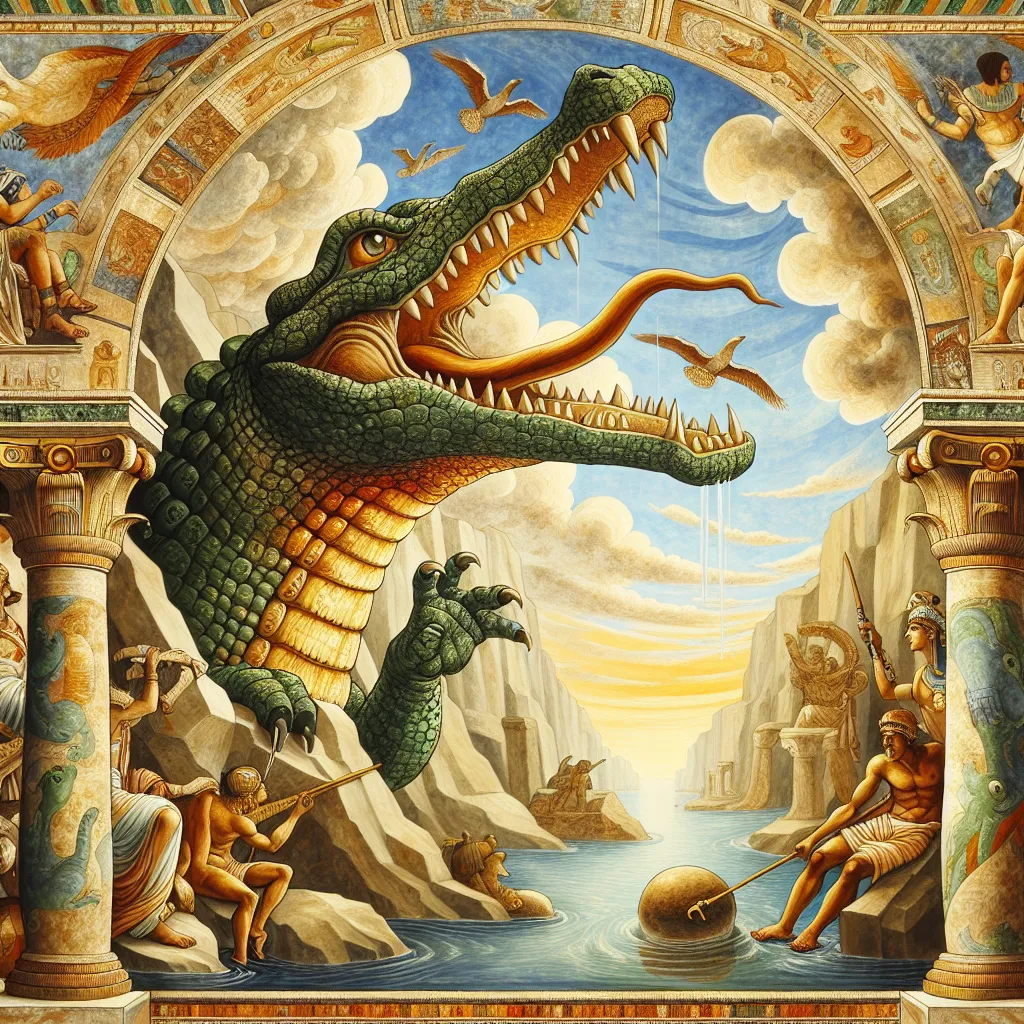
- Published on
- Authors

- Name
- You
The Breath of Sobek: Strength and Protection in Egyptian Beliefs
Introduction
In the rich tapestry of ancient Egyptian mythology, Sobek, the powerful crocodile god, stands as a testament to the intertwining of nature, divinity, and human culture. Sobek's essence, specifically his breath, symbolizes primordial strength and divine protection. This article explores the dualities and depth of Sobek, blending advanced science with mystical wisdom to provide a comprehensive understanding of his role in Egyptian beliefs.
Sobek: The Crocodile God
Mythological Origins
Sobek is often depicted with the head of a crocodile and the body of a man. He represents the might of the Nile and the fertility it bestows upon the lands of Egypt. His mythology is deeply rooted in the natural world, highlighting the Egyptians' respect and fear of crocodiles, which were both protectors and threats.
Symbolism of Breath
Breath is a potent symbol in many ancient cultures, representing life force and spiritual power. In the context of Sobek, breath embodies strength and vitality. The Egyptian term for breath, "Shu," also means light, reinforcing the divine aspect of breathing life and strength into the world.
| Aspect | Sobek's Symbolism |
|---|---|
| Physical Form | Crocodile, Man, Hybrid |
| Domains | Nile, Fertility, Military Strength |
| Breath | Life Force, Divine Light, Protection |
| Attributes | Ferocity, Bravery, Guarding the Pharaoh |
Scientific Correlation
The Role of Breath in Physiology
From a scientific perspective, breath is fundamental to life. Oxygen intake through respiration is vital for cellular respiration, a process that produces the energy necessary for physical strength and endurance. This biological necessity echoes Sobek's role as a provider of vital strength and protection.
The Power of Breath in Modern Science
Modern advancements in respiratory analytics and biochemistry reveal the profound impact of controlled breathing on physical and mental health. Techniques such as diaphragmatic breathing and pranayama (from ancient yogic practices) are known to enhance cognitive function, reduce stress, and bolster overall health. These scientific findings align with Sobek's symbolism, where breath is an instrument of power and resilience.
Mystical Practices Involving Sobek
Ritual for Strength
To invoke the strength of Sobek, ancient priests would perform elaborate rituals involving offerings of fish and crocodile-shaped amulets. Here's a simplified version that can be practiced today:
- Preparation: Create a quiet space and gather symbols of water, such as a bowl of water or images of the Nile.
- Invocation: Chant the following, visualizing the crocodile god: "Sobek, guardian of the Nile, we seek your strength and protection."
- Breath Focus: Breathe deeply and rhythmically, imagining inhaling Sobek's strength and exhaling any weakness.
Protection Ceremony
For protection, several ancient texts recommend crafting and consecrating amulets in Sobek's form:
- Crafting the Amulet: Using clay or stone, create or acquire an amulet shaped like a crocodile.
- Consecration Ritual: Under a full moon, bathe the amulet in a bowl filled with Nile water (or symbolically charged water if unavailable), chanting, "Sobek, bestow your protective breath upon this talisman."
- Wear or Place the Amulet: Keep the amulet close, wearing it around your neck or placing it in an area needing protection.
Conclusion
Sobek, the crocodile god, offers a profound intersection between the physical and mystical realms, symbolizing strength and protection through the essence of breath. His presence in Egyptian mythology teaches us that the powers of nature, when revered and understood, can imbue us with resilience and safeguard our well-being.
Through the lens of science and mysticism, we can appreciate Sobek not only as a figure of ancient worship but as a timeless emblem of vitality and divine protection.
"The breath of life, in its silent grace, guards and empowers, much like the eternal gaze of Sobek over the waters of the Nile."
References
- Wilkinson, R. H. (2003). The Complete Gods and Goddesses of Ancient Egypt. Thames & Hudson.
- Gardiner, A. (1961). Egypt of the Pharaohs: An Introduction. Clarendon Press.
- Respiratory Physiology: The Essentials, West, John B. (2012). LWW.
- Yoga: The Science of Breath, Ramacharaka, Yogi (1904). F. A. Drake.
Feel free to share your thoughts and experiences with Sobek or your interpretation of his mythical significance in the comments below.
